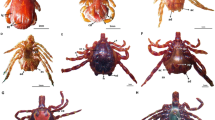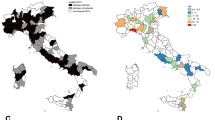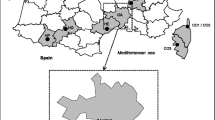Abstract
Background
Newly recognized endemic foci for human babesiosis include Europe, where Ixodes ricinus, a vector for several species of Babesia, is the most commonly identified tick. Vector-based surveillance provides an early warning system for the emergence of human babesiosis, which is likely to be under-reported at emerging sites. In the present study, we set out to screen I. ricinus collected from Danish domestic dogs for Babesia, in order to identify whether humans in Denmark are exposed to the parasite.
Findings
A total of 661 ticks (Ixodes spp.) were collected from 345 Danish domestic dogs during April-September 2011 and pooled, one sample per dog. DNA was extracted from each sample and examined by PCR and sequencing for Rickettsia spp., Borrelia burgdorferi sensu lato, Bartonella spp., Francisella tularensis, Candidatus Neoehrlichia mikurensis, and Babesia spp. In total, 34% of the samples were positive for tick-borne microorganisms potentially pathogenic to humans: Rickettsia spp. were detected in 16% of the pools, with 79% being R. helvetica. Borrelia burgdorferi sensu lato was found in 15%, with the main species identified as Borrelia afzelii (39%). Likewise, 8% of the samples were positive for Babesia spp. (Babesia microti, 82%; Babesia venatorum (‘EU1’), 18%). Lastly, 1% of the samples tested positive for Candidatus Neoehrlichia mikurensis, and 0.6% for Bartonella spp. No ticks were found to be infected with Francisella tularensis.
Conclusions
Our data are in support of endemic occurrence of potentially zoonotic Babesia in Denmark and confirms I. ricinus as a vector of multiple pathogens of public health concern.
Similar content being viewed by others
Findings
Tick-borne pathogens of public health concern include viruses, bacteria, and parasites. The current focus on climate-induced environmental changes potentially favouring the emergence of novel infectious diseases and changes in disease endemicity, boosts the incentive for pathogen surveillance in arthropod vectors and hosts in order to understand the epidemiology and control of these diseases.
One such emerging pathogen is Babesia, a parasite first detected in cattle but now a well-known cause of malaria-like illness in humans [1-3]. Newly recognized endemic foci for human babesiosis include Europe [4] where Ixodes ricinus, a vector of multiple species of Babesia, is common. Apparently the most common tick in Europe [5], I. ricinus has a world-wide occurrence and low host specificity, parasitising on a variety of larger mammals, including humans [6].
Human babesiosis should generally be suspected in splenectomised and otherwise immunocompromised individuals with severe febrile illnesses. The first case of human babesiosis in Denmark was reported in 2013 [7] and represented an imported case of Babesia microti infection from the United States. There are currently no other reports on autochthonous Danish cases, which could indicate that human exposure to Babesia in Denmark is low. Meanwhile, a recent study in the US [8] suggested that vector-based surveillance could provide an early warning system for the emergence of human babesiosis, which is likely to be under-reported at emerging sites. Recently, the presence of Babesia divergens and Babesia venatorum was demonstrated in Danish I. ricinus [9]. Here, we set out to expand on the knowledge of the distribution, prevalence, and species of Babesia in ticks collected in Denmark. To gain more information on tick-borne transmitted pathogens in Denmark in general, we moreover sought to identify the prevalence of tick-borne bacteria, including Borrelia, Candidatus Neoehrlichia, Bartonella, Francisella, and Rickettsia.
The survey was originally developed to identify the prevalence in Denmark of Dermacentor reticulatus, a tick commonly found in German dogs [10]. A total of 22 veterinary clinics were instructed by the companies KSL Consulting ApS and Merial Norden A/S to collect ticks from dogs from four regions of Denmark, namely South, Mid-West, and North-West Jutland plus South Funen; these areas were considered to be the most likely places to find D. reticulatus, mainly due to the proximity to Germany. Ticks were identified to species level and life cycle stage by morphological analysis [11,12]. For each animal, one or more ticks were collected. In cases where multiple I. ricinus ticks were collected per animal, ticks were pooled and analysed as a single sample. Information on sample location (municipality) and date of collection was available.
Bead-beating proved sufficient for DNA extraction when using garnet beads for middle-sized ticks (2–4 mm) and glass beads for small ticks (1–2 mm). Larger ticks had to be cut longitudinally for DNA to be extracted efficiently. However, differential DNA extraction by tick size proved difficult, since several host-tick pools contained ticks of varying sizes. Therefore, longitudinal cutting was selected as the method of choice.
DNA was extracted using QIAamp Mini Kit (QIAGEN, Hilden, Germany) according to the recommendations of the manufacturer. A variety of PCR methods were used to enable detection of DNA from different pathogens (Table 1). PCR products were sequenced (Eurofins Genomics, Ebersberg, Germany) for confirmation and species identification, which was performed by BLAST queries against the NCBI database (http://blast.ncbi.nlm.nih.gov/Blast.cgi). Representative Babesia sequences were submitted to the NCBI database (accession numbers, KP688578 and KP688579).
A total of 345 pools (one pool per animal) were included in the present study, comprising a total of 661 ticks. All ticks were I. ricinus (females, N = 533; males, N = 78). In all of the 22 sampling locations except for one, one or more pathogens were detected in one or more of the pools (Additional file 1: Table S1, Additional file 2: Figure S2). Of the 345 examined pools, 118 (34%) were found to be infected with one or more human tick-borne pathogens (Additional file 1: Table S1). Rickettsia spp. were detected in 16% of the samples, and Rickettsia helvetica accounted for 79% of the rickettsial sequences. Three cases (5%) of Rickettsia massiliae were identified, while the remainder of the Rickettsia (16%) could not be assigned to species level with confidence either due to low (~97%) sequence identity to other rickettsia or due to ambiguous DNA sequence data.
A total of 15% of the samples were positive for Borrelia burgdorferi sensu lato, and five sub-species were identified, including Borrelia afzelii (39%), Borrelia garinii (27%), Borrelia valaisiana (17%), Borrelia spielmanii (15%), and Borrelia burgdorferi sensu stricto (2%).
Likewise, 8% were positive for Babesia spp. (82% Babesia microti and 18% Babesia venatorum (‘EU1’)), 1% for Candidatus Neoehrlichia mikurensis, and 0.6% for Bartonella spp. Francisella tularensis was not detected in any of the ticks.
The four major regions sampled in the study did not appear to differ in terms of the distribution of pathogens detected in ticks. However, B. venatorum was found only in Jutland, while B. microti was found in both Funen and Jutland (Table 2). In 11/27 (41%) cases, Babesia was seen with at least one co-infecting pathogen (Additional file 1: Table S1), including one case of B. burgdorferi.
Analysis of 661 ticks identified I. ricinus as the dominating tick species infecting dogs in Denmark, and approximately one third of the ticks contained parasites and/or bacteria potentially pathogenic to humans. R. helvetica was identified as the most common pathogen, confirming previous analyses of questing ticks in Denmark [13-15].
The present data add support to a study recently performed to investigate the presence of tick-borne pathogens identified in I. ricinus collected in Denmark, France, and The Netherlands, confirming the presence of Babesia in I. ricinus in Denmark. Using a microfluidic real-time PCR assay targeting 25 bacteria and 12 parasites, Michelet et al. identified two cases of B. divergens and 19 cases of B. venatorum, analysing 94 pools of Danish questing I. ricinus nymphs sampled in the region of Zeeland, Denmark [9]. However, a few remarkable differences between the two studies could be noted. In the study by Michelet et al. [9] no cases of B. microti were detected. In the present study, B. microti was i) found in 23/345 samples (7%), ii) more common than B. venatorum, and iii) distributed all over the sampling region, which, however, did not include the island of Zeeland or any other area east of Funen. On the other hand, B. divergens was found in two cases in the study by Michelet et al. [9], while this species remained unidentified in the present study. Hence, all three main species of Babesia of potential clinical relevance to humans have been identified in Denmark, although B. microti and B. divergens may differ significantly in terms of regional distribution in this country. Of particular interest is also the fact that B. microti was identified only in Jutland and Funen and not further east in the country. Notably, B. microti detected in the present study appeared 100% genetically identical at SSU rRNA gene level to species detected in New England, where human babesiosis due to B. microti is not uncommon [16]. It should also be noted that Michelet et al. [9] used different target genes when screening for Babesia: While the SSU rRNA gene was used to detect B. venatorum, hsp70 and CCTeta were used to detect B. divergens and B. microti, respectively. It should be investigated if differences in copy number and level of intra-specific genetic diversity may affect the relative diagnostic performance of each marker. Moreover, the CCTeta assay could be applied to DNAs sequence-positive for B. microti, in order to evaluate its applicability as a general screening tool.
While human cases of B. microti infections detected in Europe may be imported (e.g. [7]), a couple of autochthonous cases have been reported [17,18]. Interestingly, a B. microti infection was found in an immunocompetent male with clinical and laboratory evidence of Lyme disease [18], indicating that co-infections by Borrelia and Babesia may be overlooked. In Europe, babesiosis occurs not only in splenectomised or immunosuppressed patients, but also in healthy individuals [19].
Rodents appear to constitute the main reservoir for B. microti [20]. In the present study, we confirmed the presence of B. microti in I. ricinus; however, it remains unknown whether I. ricinus is capable of transmitting B. microti to larger mammals, including humans. Nevertheless, seroprevalence data indicate that B. microti infections are not uncommon in Europe [19,20], and that they may have a subclinical course in otherwise healthy individuals.
Future studies should monitor the prevalence, distribution, and host specificity of Babesia in ticks from different geographical regions in Denmark and neighbouring countries in order to increase awareness and to enable assessment of the potential public health risk of contracting babesiosis in this region where infections may be emerging. Furthermore, it should be investigated, to which extent patients with Lyme disease are seropositive for Babesia. Low diagnostic sensitivity related to traditional diagnosis of acute babesiosis can be overcome by the use of Babesia-specific PCR, suitable for direct detection of the pathogen in blood samples from patients with relevant exposure and unexplained fever.
Conclusion
This study is the first to detect of B. microti in Danish ticks. We confirmed the presence of B. microti in I. ricinus collected at multiple locations in Denmark. Our data evinces endemic occurrence of potentially zoonotic Babesia in Denmark and confirms I. ricinus as a vector of multiple pathogens of public health concern. Awareness of the potential impact of Babesia on public health in Scandinavia could be increased by monitoring the prevalence, distribution, and host specificity of Babesia in ticks.
References
Zhou X, Xia S, Huang JL, Tambo E, Ge HX, Zhou XN. Human babesiosis, an emerging tick-borne disease in the People’s Republic of China. Parasit Vectors. 2014;7:509.
Stramer SL, Hollinger FB, Katz LM, Kleinman S, Metzel PS, Gregory KR, et al. Emerging infectious disease agents and their potential threat to transfusion safety. Transfusion. 2009;49 Suppl 2:1S–29.
Hildebrandt A, Gray JS, Hunfeld KP. Human babesiosis in Europe: what clinicians need to know. Infection. 2013;41:1057–72.
Gigandet L, Stauffer E, Douet V, Rais O, Moret J, Gern L. Prevalence of three zoonotic Babesia species in Ixodes ricinus (Linné, 1758) nymphs in a suburban forest in Switzerland. Vector Borne Zoonotic Dis. 2011;11:363–6.
Bonnet S, Michelet L, Moutailler S, Cheval J, Hébert C, Vayssier-Taussat M, et al. Identification of parasitic communities within European ticks using next-generation sequencing. PLoS Negl Trop Dis. 2014;8, e2753.
Chauvin A, Moreau E, Bonnet S, Plantard O, Malandrin L. Babesia and its hosts: adaptation to long-lasting interactions as a way to achieve efficient transmission. Vet Res. 2009;40:37.
Holler JG, Röser D, Nielsen HV, Eickhardt S, Chen M, Lester A, et al. A case of human babesiosis in Denmark. Travel Med Infect Dis. 2013;11:324–8.
Diuk-Wasser MA, Liu Y, Steeves TK, Folsom–O’Keefe C, Dardick KR, Lepore T, et al. Monitoring human babesiosis emergence through vector surveillance New England, USA. Emerg Infect Dis. 2014;20:225–31.
Michelet L, Delannoy S, Devillers E, Umhang G, Aspan A, Juremalm M, et al. High-throughput screening of tick-borne pathogens in Europe. Front Cell Infect Microbiol. 2014;4:103.
Dautel H, Dippel C, Oehme R, Hartelt K, Schettler E. Evidence for an increased geographical distribution of Dermacentor reticulatus in Germany and detection of Rickettsia sp. RpA4. Int J Med Microbiol. 2006;296(40):149–56.
Weidner H, Bestimmungstabellen der Vorratsschädlinge und des Hausungeziefers Mitteleuropas. Spektrum Akademischer Verlag. 1993.
Hillyard PD. Ticks of North-West Europe, vol. 52. Montford Bridge, UK: The Linnean Society of London and The Estaurine and Coastal Sciences Association; Field Studies Council Publications. 1996.
Kantsø B, Svendsen CB, Jensen PM, Vennestrøm J, Krogfelt KA. Seasonal and habitat variation in the prevalence of Rickettsia helvetica in Ixodes ricinus ticks from Denmark. Ticks Tick Borne Dis. 2010;1:101–3.
Svendsen CB, Krogfelt KA, Jensen PM. Detection of Rickettsia spp. in Danish ticks (Acari: Ixodes ricinus) using real-time PCR. Scand J Infect Dis. 2009;41:70–2.
Skarphédinsson S, Lyholm BF, Ljungberg M, Søgaard P, Kolmos HJ, Nielsen LP. Detection and identification of Anaplasma phagocytophilum, Borrelia burgdorferi, and Rickettsia helvetica in Danish Ixodes ricinus ticks. APMIS. 2007;115:225–30.
Smith RP, Elias SP, Borelli TJ, Missaghi B, York BJ, Kessler RA, et al. Human babesiosis, Maine, USA, 1995–2011. Emerg Infect Dis. 2014;20:1727–30.
Hildebrandt A, Franke J, Meier F, Sachse S, Dorn W, Straube E. The potential role of migratory birds in transmission cycles of Babesia spp., Anaplasma phagocytophilum, and Rickettsia spp. Ticks Tick Borne Dis. 2010;1:105–7.
Meer-Scherrer L, Adelson M, Mordechai E, Lottaz B, Tilton R. Babesia microti infection in Europe. Curr Microbiol. 2004;48:435–7.
Martinot M, Zadeh MM, Hansmann Y, Grawey I, Christmann D, Aguillon S, et al. Babesiosis in immunocompetent patients. Europe Emerg Infect Dis. 2011;17:114–6.
Yabsley MJ, Shock BC. Natural history of zoonotic Babesia: Role of wildlife reservoirs. Int J Parasitol Parasites Wildl. 2013;2:18–31.
Casati S, Sager H, Gern L, Piffaretti JC. Presence of potentially pathogenic Babesia sp. for human in Ixodes ricinus in Switzerland. Ann Agric Environ Med. 2006;13:65–70.
Bereswill S, Hinkelmann S, Kist M, Sander A. Molecular analysis of riboflavin synthesis genes in Bartonella henselae and use of the ribC gene for differentiation of Bartonella species by PCR. J Clin Microbiol. 1999;37:3159–66.
Clark K, Hendricks A, Burge D. Molecular identification and analysis of Borrelia burgdorferi sensu lato in lizards in the southeastern United States. Appl Environ Microbiol. 2005;71:2616–25.
Johnson BJ, Happ CM, Mayer LW, Piesman J. Detection of Borrelia burgdorferi in ticks by species-specific amplification of the flagellin gene. Am J Trop Med Hyg. 1992;47:730–41.
Byström M, Böcher S, Magnusson A, Prag J, Johansson A. Tularemia in Denmark: identification of a Francisella tularensis subsp. holarctica strain by real-time PCR and high-resolution typing by multiple-locus variable-number tandem repeat analysis. J Clin Microbiol. 2005;43:5355–8.
Acknowledgements
Lis Lykke Wassmann is thanked for excellent laboratory assistance.
Author information
Authors and Affiliations
Corresponding author
Additional information
Competing interests
The authors have no competing interests to declare. No financial support was received for this study.
Authors’ contributions
CRS: Data analysis and manuscript preparation. DAM: Study design, laboratory work, data analysis, manuscript preparation. LOA: Data analysis, primer design, laboratory work, manuscript preparation. JSJ: Data analysis, primer design, manuscript preparation. KAK: Data analysis, manuscript preparation. KSL: Study design, manuscript preparation. HVN: Study design, Data analysis, manuscript preparation. All authors approved of the submitted version of the manuscript.
Additional files
Additional file 1: Table S1.
Pathogens detected in the study according to sampling location and co-infecting organisms.
Additional 2: Figure S1.
Map of Denmark (excluding the island of Bornholm) displaying areas of tick sampling by municipality indicated by the numbers 1—15. For cross-reference, please see the Additional file 1: Table S1.
Rights and permissions
This article is published under an open access license. Please check the 'Copyright Information' section either on this page or in the PDF for details of this license and what re-use is permitted. If your intended use exceeds what is permitted by the license or if you are unable to locate the licence and re-use information, please contact the Rights and Permissions team.
About this article
Cite this article
Stensvold, C.R., Al Marai, D., Andersen, L.O. et al. Babesia spp. and other pathogens in ticks recovered from domestic dogs in Denmark. Parasites Vectors 8, 262 (2015). https://doi.org/10.1186/s13071-015-0843-0
Received:
Accepted:
Published:
DOI: https://doi.org/10.1186/s13071-015-0843-0




